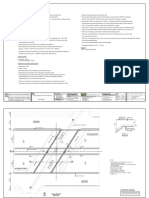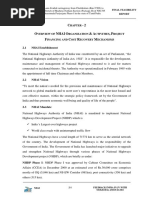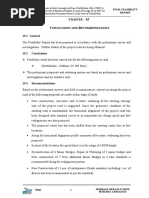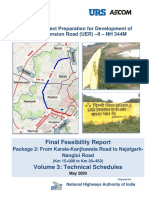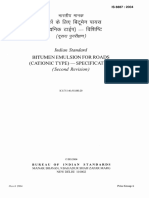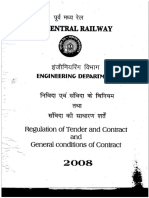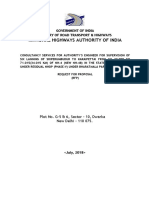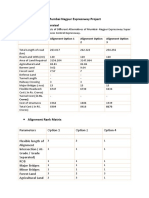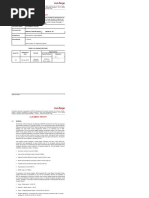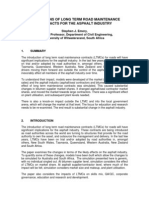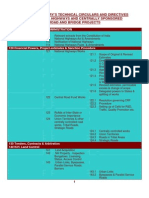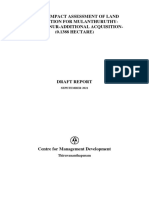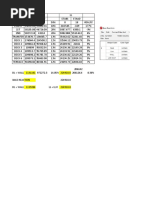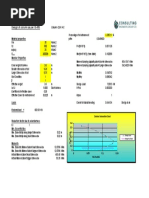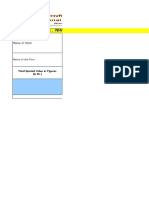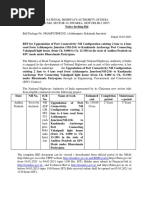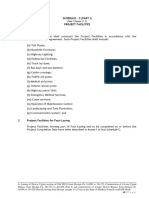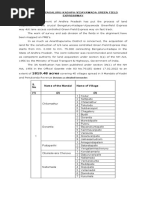Chapter - 11 CH
Chapter - 11 CH
Uploaded by
Praveen CyssanCopyright:
Available Formats
Chapter - 11 CH
Chapter - 11 CH
Uploaded by
Praveen CyssanOriginal Title
Copyright
Available Formats
Share this document
Did you find this document useful?
Is this content inappropriate?
Copyright:
Available Formats
Chapter - 11 CH
Chapter - 11 CH
Uploaded by
Praveen CyssanCopyright:
Available Formats
Construction of Four Lane divided carriageway from Chettikulam (Km.
7/300) to
FINAL FEASIBILITY
Natham (Km.36/690) Stretch of Madurai-Natham Section (Package-II) of NH-785
REPORT
on EPC mode under Bharatmala Pariyojana Phase-I in the state of TamilNadu.
CHAPTER - 11
11 INITIAL SOCIAL ASSESSMENT AND PRELIMINARY LAND
ACQUISITION / RESETTLEMENT PLAN
11.1 Introduction
11.1.1 Project Description
National Highways Authority of India (NHAI) has been entrusted to implement the
development of projects for few selected stretches / corridors through various funding
mechanism either through Public Private Partnership (PPP) basis or its own budgetary
sources or loan assistance from Asian Development Bank (ADB), World Bank etc. The
National Highways Authority of India has accordingly taken up project preparation of
certain stretches / corridors of existing National Highways that passes through various
states of the country.
Accordingly, six sections have been identified for implementation under this programme
and one part of the programme is to develop Chettikulam – Natham stretch on NH-785
for a total length of 29.390 kms in the state of Tamil Nadu.
Subsequently, NHAI has appointed M/s. Feedback Infra in JV with M/s. Mukesh &
Associates in association with M/s. Cos Consultancy services, as DPR Consultant for the
Consultancy Services for Feasibility Studies and Preparation of Detailed Project Report
of 4-laning of Chettikulam to Natham (Total Length – 29.390 kms) on NH-785 in the
State of Tamil Nadu.
11.1.2 Expected project benefits
By implementing this project, it is expected to achieve the following benefits.
Improved road transport corridors & road network connectivity
Safe journey
Time saving
Reduced risk
Provides basic amenities to the villages along the highway
Economic benefits in terms of
NHAI FEEDBACK INFRA IN JV WITH
MUKESH & ASSOCIATES
1
Construction of Four Lane divided carriageway from Chettikulam (Km.7/300) to
FINAL FEASIBILITY
Natham (Km.36/690) Stretch of Madurai-Natham Section (Package-II) of NH-785
REPORT
on EPC mode under Bharatmala Pariyojana Phase-I in the state of TamilNadu.
Savings in vehicle operating cost (VOC)
Time savings for passenger & goods
Savings in road maintenance cost
Avoid congestion
Industrialization & other economic activities will develop rapidly which will lead
to increase in production & bring prosperity in those areas.
Restaurants, Hotels, Workshops, Educational Institution & other business
activities will emerge along the road.
Lower transport costs for freight & passenger of motorized & non-motorized
vehicles.
11.1.3 Negative impacts
Certain negative social impacts are inherent and unavoidable in any of the development
projects and our project is also no exception, as the following negative impacts are
anticipated due to the implementation of the project.
Loss of source of income to PAP’s
Loss of private, immovable properties, including agriculture land, commercial &
residential buildings, shops, wells, trees, standing crops, etc.,
Loss of civil amenities
11.2 Resettlement & Rehabilitation action plan
This chapter summarizes the resettlement and rehabilitation action plan for the 4-laning of
Chettikulam – Natham section of NH-785 from km 7/300 to 36/690 in the State of Tamil
Nadu. This mainly focuses on the approaches for minimizing / mitigating social and
economic impacts due to the implementation of the project, especially on vulnerable
group.
11.3 Need for settlement action plan
In most of the development projects, some people or groups of people or the entire
community are directly or indirectly benefited and some are adversely affected. Even
though the project contributes to some positive benefits, it will have some adverse
impacts associated with land acquisition and displacement of people.
NHAI FEEDBACK INFRA IN JV WITH
MUKESH & ASSOCIATES
2
Construction of Four Lane divided carriageway from Chettikulam (Km.7/300) to
FINAL FEASIBILITY
Natham (Km.36/690) Stretch of Madurai-Natham Section (Package-II) of NH-785
REPORT
on EPC mode under Bharatmala Pariyojana Phase-I in the state of TamilNadu.
The existing ROW along the entire length of the project road is only 13.50 – 66.50 m
only and therefore involves large scale land acquisition to have the prescribed 60.0m
ROW, which will affect large number of people living along the project road and some of
whom will be displaced.
This resettlement and rehabilitation action plan (RAP) addresses the issues related to land
acquisition and involuntary displacement of people. The aim of the RAP is to minimize
the hardship of the displaced and the otherwise impacted people. The RAP also aims to
help the PAPs’ to have better or at least maintained their pre-project economic status.
The RAP meets the requirement of Government of India’s Resettlement & Rehabilitation
(R&R) policy, consistent with the World Bank’s (Operational Directive 4.30) regulations,
policies and procedures including those on public participation, environmental assessment
and indigenous people.
11.4 R & R principles and guidelines
The resettlement and rehabilitation principles adopted for this project will provide
compensation, resettlement & rehabilitation assistance to all Project Affected Persons
(PAPs) (i.e., people affected due to the loss of land, residences, business establishments,
etc.,) in the corridor of impact which is 60.0 m along the existing alignment.
The basic resettlement principles and guidelines include:
Where land acquisition is required, it will be carried out according to the National
Highway Act (NH Act), 1956 and in a way to minimize the adverse impacts and
to avoid displacement as much as possible.
Cash compensation for the land, at the market value will be provided to
households affected by the loss of acquired land by the competent authority
appointed under NH Act.
Cash compensation for the affected structures of the title holders will be paid by
the competent authority. The replacement cost will be calculated by the certified
value as per PWD schedule of rates (without depreciation) of the concerned
district / division / zone of Tamil Nadu for the structure of the title holders. For
items not covered in the SOR, market rates will be considered.
NHAI FEEDBACK INFRA IN JV WITH
MUKESH & ASSOCIATES
3
Construction of Four Lane divided carriageway from Chettikulam (Km.7/300) to
FINAL FEASIBILITY
Natham (Km.36/690) Stretch of Madurai-Natham Section (Package-II) of NH-785
REPORT
on EPC mode under Bharatmala Pariyojana Phase-I in the state of TamilNadu.
Provision for relocation of the SBE’s (Small Business Enterprises) in the form of
vendor market as well as assisting restoration of business and local economics.
Provision for multiple options for resettlement (self-relocation or assisted
relocation) of the affected residential structure of the titleholders and non-title
holders including informal dwellers / squatters.
Shifting assistance to the owners of residential structures and encroachers /
squatter households and titleholder for shifting of household goods and assets.
Transitional assistance to PAP’s due to inability to maintain livelihood during
shifting.
Assistance to affected persons in their efforts to improve their livelihood and
standards of living or at least to restore the pre-project living status.
Rehabilitation assistance including assistance for re-establishing last business and
work days (for employees) due to the project.
Special measures and assistance for vulnerable groups such as scheduled castes,
scheduled tribes female headed households, disable persons, etc.,
Public consultations and providing opportunities to PAP’s to participate in
planning and implementing resettlement programmes.
Providing grievance redressal mechanism by way of providing grievance redress
committee at district level to ensure speedy resolutions of disputes, if any.
Involvement of women and vulnerable groups in all activities related to
resettlement planning, implementation and monitoring.
Before taking possession of the acquired land, compensation will be paid to the
PAP’s, prior to commencement of construction work.
The resettlement plan will include a fully item-wised budget and implementation
schedule.
11.5 Entitlement frame works
Based on the assessed impacts and the broad entitlement framework, the project affected
persons will be entitled to the following five types of compensation and assistance:
Compensation for loss of land, crops / trees
NHAI FEEDBACK INFRA IN JV WITH
MUKESH & ASSOCIATES
4
Construction of Four Lane divided carriageway from Chettikulam (Km.7/300) to
FINAL FEASIBILITY
Natham (Km.36/690) Stretch of Madurai-Natham Section (Package-II) of NH-785
REPORT
on EPC mode under Bharatmala Pariyojana Phase-I in the state of TamilNadu.
Compensation for structures (Residential & Commercial) and other immovable
assets
Assistance for loss of business / wage income
Assistance for resettlement and relocation
Rebuilding and restoration of community resources / facilities
11.6 Project road description
The project road from km 7/300 to km 36/690 of Chettikulam to Natham section is a
segment of NH-785 is passing through the State of Tamil Nadu.
11.6.1 Location
The starting point of the project road is located within the non - urban limits of
Chettikulam at km 7/300 and ends at km 36/690 at Natham, Dindigul district. The project
area is located within the geographical co-ordinates of
North Latitude = 09.925 N ~ 10.222 N
East Longitude = 78.120 E ~ 78.153 E
11.6.2 Project proposals
The project envisages widening of the existing road from km 7/300 to km 36/690 of
Chettikulam to Natham section of NH-785 to 4-laning divided carriageway configuration
with improved facilities. The improvement works mainly comprise 4-laning of the
existing road, raising of formation level, provision for service roads at built-up areas,
provision for drains and CD structures, etc.
The major improvements proposed are
Reconstruction of 6 Minor Bridges, Repair & Widening of 2 minor bridges and
New construction of 7 New additional Minor Bridges to 6 lane standards is
recommended along the realignment portion.
New Construction of 11 nos. of underpasses (Grade separator) including 1 no. of
flyover has been recommended as per the standards.
Reconstruction of 11 Pipe culverts as Box to 4 lane standards are recommended
along the Project stretch.
NHAI FEEDBACK INFRA IN JV WITH
MUKESH & ASSOCIATES
5
Construction of Four Lane divided carriageway from Chettikulam (Km.7/300) to
FINAL FEASIBILITY
Natham (Km.36/690) Stretch of Madurai-Natham Section (Package-II) of NH-785
REPORT
on EPC mode under Bharatmala Pariyojana Phase-I in the state of TamilNadu.
Reconstruction of 8 Slab culvert as Box culvert and Repair & Widening of 5 Slab
culverts to 4 lane standards is recommended along the realignment portion.
New construction of 28 Box culverts to 4 lane standards is recommended along
the realignment portion.
A Toll plaza is proposed at Km 21+020 (Ex. Chainage Km 24/050) Pudur.
A truck lay bay is proposed at Km 24+250 (Ex. Chainage 27/300).
Provision of slip road totaling to a length 18.010 Km and service road totaling to a
length 2.720 Km has been proposed.
Provision of Wayside amenities at km 20+750 (Ex. Chainage Km 23/800) Pudur.
11 nos. of Major Junctions and 12 nos. of Minor Junctions has been proposed at
Chettikulam to Natham stretch.
Realignment and Geometric improvements to the S-curves were required, hence
Realignment at 7 locations and Curve Improvements at 10 locations were
proposed respectively.
24 Bus lay bay with Bus Shelters has been proposed along the Project road.
11.7 LA proposals
The available ROW along the entire length of the project road varies from 10.0m to
30.0m. The existing road has 7.0m to 7.6m wide carriageway throughout the entire
length with 1.5m wide paved shoulders on both sides at built-up areas. The project road
predominantly passes through plain terrain over shallow embankment. The existing
vertical profile of the project road is within acceptable standards as per IRC: SP 84-2014.
In the entire stretch of the project road, the land use predominantly seen is of the types
built up area and agricultural land. The Project road has agriculture lands either on one
side or on both sides of the project road. This land use comprises of the major types of
built up land use as residential, commercial, public buildings. The project road passes
through the heavily built up area, Agricultural land and the present road has the 4-lane
road standards. More number of educational institutions, hospitals, fuel retail outlets,
police stations, religious places, commercial buildings etc are also present along the
project road.
NHAI FEEDBACK INFRA IN JV WITH
MUKESH & ASSOCIATES
6
Construction of Four Lane divided carriageway from Chettikulam (Km.7/300) to
FINAL FEASIBILITY
Natham (Km.36/690) Stretch of Madurai-Natham Section (Package-II) of NH-785
REPORT
on EPC mode under Bharatmala Pariyojana Phase-I in the state of TamilNadu.
The existing horizontal alignment of the project road mostly runs in straight alignment
with around 33 Nos. of horizontal curves of easy curvature.
A total of 49 nos. of various types of cross drainage structures are present all along the
project road. The various cross drainage structures are 6 minor bridges, 18 slab culverts
and 25 pipe culverts.
Based on the proposed improvements and as per NHAI’s requirements, the proposed right
of way is kept as 60m, which emerged to the need for acquisition of additional land.
To frame the proposal for acquisition of land, due care was emphasized in finalizing the
proposed alignment, so as to avoid large-scale acquisition of land and buildings.
Generally, eccentric widening is proposed to be adopted along the existing alignment and
as such the plan of acquisition has been prepared in such a way that from the proposed
centre line, proposed ROW on either side would be 60.0 m. Total land required for the
project is 116.43 hectares.
The preliminary studies carried out to prepare this RAP, show extensive occupancy of
project roadside areas including rural settlements, consisting of numerous homes,
business and public facilities. The proposed widening scheme along with other
improvements proposed would impact road side residential structures, business
establishments, religious shrines and structures, agriculture lands, public buildings, etc.,
However, resettlement will be required only where residential and commercial buildings
are to be either fully demolished or taken to the extent that they are rendered
uninhabitable or useless. Displaced residents of these buildings will have to be relocated.
Similarly affected business establishments, public buildings and religious structures are
also to be relocated.
Rehabilitation will be required where resettlement, relocation or other project impacts
result in loss of livelihood or income. In such cases, it is essential to restore the economic
status of affected persons to better or at least pre-project levels.
In most cases, the project will not require either full demolishing or the taking of
residential / commercial structures to the extent that either resettlement or relocation will
be necessary.
NHAI FEEDBACK INFRA IN JV WITH
MUKESH & ASSOCIATES
7
Construction of Four Lane divided carriageway from Chettikulam (Km.7/300) to
FINAL FEASIBILITY
Natham (Km.36/690) Stretch of Madurai-Natham Section (Package-II) of NH-785
REPORT
on EPC mode under Bharatmala Pariyojana Phase-I in the state of TamilNadu.
Considering the above, it is essential to prepare the resettlement and rehabilitation plan
for the entire project area, which would essentially include:
Identification of the chainage wise available ROW and proposed ROW
Kilometer wise and village wise land requirement
Details of the existing structures on the proposed lands to be acquired.
Rates of land (Both market value and guideline value)
11.8 Vulnerable group
The social, cultural and economic structures in Indian society are heterogeneous and
complex. Large sections of the society suffer social deprivation and live below poverty
line (BPL). Among the total population in the project area, the Scheduled Castes and
Scheduled Tribes accounted for 18.19% and 0.187% of the population respectively and
around 27.50% of people live below poverty line in Madurai and Dindigul districts.
Agriculture is the predominant occupation in the project area, besides small trade, as most
of the work depends upon agriculture. Therefore, the employment opportunities have not
been diversified enough to give villagers, better non-farming work.
The main vulnerable groups are classified as below:
Schedule caste and schedule tribes
Poor or landless people
Rural women headed households
Children and disabled people
Since agriculture is the main occupation of these groups and for being land less, they are
much more dependent on the big and medium farmers who are having lands along the
proposed right of way. Due to the proposed acquisition of land, these land owners will get
compensation due to loss of their land but the dependent of these lands, the vulnerable
groups will be left unhelpful. Their specific need is that, if they are displaced, they should
get jobs or opportunities with necessary up gradation of skills through training.
These groups of people would need to be given special assistance and help in attaining a
better living standard, once they are resettled.
NHAI FEEDBACK INFRA IN JV WITH
MUKESH & ASSOCIATES
8
Construction of Four Lane divided carriageway from Chettikulam (Km.7/300) to
FINAL FEASIBILITY
Natham (Km.36/690) Stretch of Madurai-Natham Section (Package-II) of NH-785
REPORT
on EPC mode under Bharatmala Pariyojana Phase-I in the state of TamilNadu.
Similarly, the resettlement action plan addresses the provision for necessary support and
assistance to the other vulnerable groups such as handicapped, children, etc., particularly
those who are poor, illiterate and lacking in various skills to get employment.
Vulnerable people would receive targeted support and special attention from the project
and are to be provided with more options and support mechanisms than those not
considered vulnerable.
11.9 Efforts to minimise / eliminate displacement
The prime objective of the RAP is to minimize / eliminate negative impacts on the people
/ community because of the project execution. As such, due consideration has been given
during project preparation to minimize the negative impacts within the limitations of
technical requirements and cost effectiveness.
Even though many benefits are expected from the project, social assessments indicate
potential adverse impacts on roadside communities, which include loss of land, assets and
livelihood. Every effort has however been made to reduce potential direct negative
impacts of the project, both in terms of environment and social issues. Designs have been
so prepared to minimize the negative impacts, where possible from a technical and
economical perspective.
The project corridor passes through broad land use category namely built-up areas. The
built-up areas generally have scattered developments on either side of the road.
Considering the above concentric widening is proposed in built-up settlement areas and
eccentric widening in other areas, to reduce the environmental and social impact and
consequently to minimize displacement.
11.10 Income Restoration
Even though significant benefits are anticipated through development projects, it may
have certain adverse impact on the income of project affected persons. They also have a
negative impact on the socio-cultural systems of affected communities. The basic
postulates of all developmental activities should be that, no one is worse of than the pre-
project level. Restoration of pre-project levels of income is an important part of
rehabilitating socio economic and cultural system in affected communities.
NHAI FEEDBACK INFRA IN JV WITH
MUKESH & ASSOCIATES
9
Construction of Four Lane divided carriageway from Chettikulam (Km.7/300) to
FINAL FEASIBILITY
Natham (Km.36/690) Stretch of Madurai-Natham Section (Package-II) of NH-785
REPORT
on EPC mode under Bharatmala Pariyojana Phase-I in the state of TamilNadu.
To achieve this goal, preparation of income restoration programs under rehabilitation
action plan, should be designed in consultation with the affected persons and they should
explicitly acknowledge the program. Successful income restoration is achieved primarily
when projects allow resettlers to share the immediate benefits created by the proposed
project that caused displacement by:
Helping resettlers to generate commercial establishments along the newly
constructed highway.
Helping them to develop their existing income generating activity.
Moving resettlers to the newly irrigated command areas without affecting the
social balance.
Helping them in building more durable houses and their non-land assets.
Helping them in developing skills by conducting skills training programme
It is essential to understand the background of the PAP’s and their options, so that
suitable skill training programme could be designed and targeted.
11.11 Key elements of Resettlement Action Plan (RAP)
The main aim of the resettlement action plan is to minimize / eliminate the adverse
impact on the people and community due to the implementation of the project. The
following key elements are considered while designing the resettlement plan. As such the
following key elements are considered for framing the resettlement plan:
Exploring alternative design options to minimize involuntary resettlement.
Carrying out socio economic surveys and census of affected people to identify all
losses and all affected persons.
Involve all PAP’s and stakeholders in consultative process including vulnerable
groups.
Compensation to all affected persons including non-title holders for all their losses
at replacement rates.
NHAI FEEDBACK INFRA IN JV WITH
MUKESH & ASSOCIATES
10
Construction of Four Lane divided carriageway from Chettikulam (Km.7/300) to
FINAL FEASIBILITY
Natham (Km.36/690) Stretch of Madurai-Natham Section (Package-II) of NH-785
REPORT
on EPC mode under Bharatmala Pariyojana Phase-I in the state of TamilNadu.
Where relocation of housing is required, develop relocation options in
consultation with affected persons and host communities in order to restore living
standards.
Establishing appropriate income restoration programmes with objectives to
improve or at least restore their pre-project income levels.
11.12 Impact assessment
11.12.1 Magnitude of impact
The proposed widening scheme involves large scale land acquisition which is estimated
as 116.43 ha. Besides, large number of non-land assets such as public buildings,
commercial structures, residential buildings, etc. is required to be acquired for the
proposed widening.
An abstract of land and non-land assets being impacted is furnished below:
S.No. Assets Total
A. Land assets
1. Total land to be acquired 177.78 ha
2. Existing land available 61.348 ha
3. Extent of land to be acquired 116.43 ha
11.12.2 Type of impact
11.12.2.1 Loss of lands & crops
The major direct impacts anticipated due to the implementation of any such development
projects are loss of lands. The project is likely to have more impacts on agricultural lands
and on the allied activities related to agriculture. Standing crops including commercial
and food crops, trees, agricultural structures, such as wells, etc., are also going to be
affected.
11.12.2.2 Loss of residential structure
Direct losses of assets or livelihoods are also anticipated due to the proposed project
which may lead to loss of residential houses (permanent & semi-permanent) and other
NHAI FEEDBACK INFRA IN JV WITH
MUKESH & ASSOCIATES
11
Construction of Four Lane divided carriageway from Chettikulam (Km.7/300) to
FINAL FEASIBILITY
Natham (Km.36/690) Stretch of Madurai-Natham Section (Package-II) of NH-785
REPORT
on EPC mode under Bharatmala Pariyojana Phase-I in the state of TamilNadu.
structures like cattle sheds, compound wall, toilets, etc., The common loss is the
displacement of road side small houses.
11.12.2.3 Loss of Income / Business opportunities
The displacement caused by the proposed project may lead to loss of livelihood or income
opportunities, either temporarily or permanently. The common loss is the displacement of
business structures such as small road side shops, hotels, etc.,
11.12.2.4 Indirect impacts
In addition to direct losses of assets or livelihoods, the project is likely to have more
impact on the population living along the corridor of influence. While many of these
impacts are positive, some adverse impacts are also anticipated. This may include road
safety, access to water and sanitation, access to common property resources, highway
related diseases and impact on non-motorized traffic such as pedestrians, bullock carts,
etc., Community owned assets such as temples, mosques, schools, places of worships and
burial grounds, etc., may also be affected.
11.13 Entitlements
The acquisition of land proposed along the project road for the proposed widening
scheme would be carried out as per National Highways Act-1956, which provide
compensation for properties to be acquired and support to be extended for meeting the
replacement value of the property. The persons affected by the project, both title holders
and non-title holders, who have economic interest or loss of livelihood shall be assisted as
per the broad principles of the principles and policy frame work of NHAI.
As per ‘Principles and Policy Frame work’ of the National Highways Authority of India,
the broad entitlement framework is applicable to 3 categories of support group, as
follows:
Project affected families & households
Project affected adult individuals
Project affected groups
NHAI FEEDBACK INFRA IN JV WITH
MUKESH & ASSOCIATES
12
Construction of Four Lane divided carriageway from Chettikulam (Km.7/300) to
FINAL FEASIBILITY
Natham (Km.36/690) Stretch of Madurai-Natham Section (Package-II) of NH-785
REPORT
on EPC mode under Bharatmala Pariyojana Phase-I in the state of TamilNadu.
Specific entitlements and unit costs have not been provided in the policy. However,
based on the assessed impacts and the broad entitlement frame work, the affected persons
in the project will be entitled for the following 5 types of compensation and assistance:
Compensation for loss of land, crops & trees
Compensation for structures (residential and commercial) and other immovable
assets.
Assistance for loss of business, wage / income
Assistance for resettlement and rehabilitation
Rebuilding and restoration of community resources / facilities.
The PAP’s are categorized based on the degree of impact and the specific entitlement for
each category.
11.14 Roles & Responsibilities
11.14.1 NHAI Corporate
The Chief General Manager is the incharge of the overall project activities and
participates in the state level committee to facilitate land acquisition and pre-construction
activities.
The responsibilities of the General Manager – ESDU, would include:
Co-ordinate the implementation of R&R activities with Corporate and staff at PIU
level.
Review the micro plans prepared by the NGO
Review the work progress reports prepared by the implementing NGO
Monitoring the progress on R&R and land acquisition.
Appoint NGO for R&R implementation and evaluation consultants for end of
project evaluation and impact assessment.
Provide advisory support to CGM for selecting supervision consultant for
monitoring RAP.
Plan and conduct training progress for capacity building of staff.
NHAI FEEDBACK INFRA IN JV WITH
MUKESH & ASSOCIATES
13
Construction of Four Lane divided carriageway from Chettikulam (Km.7/300) to
FINAL FEASIBILITY
Natham (Km.36/690) Stretch of Madurai-Natham Section (Package-II) of NH-785
REPORT
on EPC mode under Bharatmala Pariyojana Phase-I in the state of TamilNadu.
The responsibilities of Deputy General Manager (Environment) and Manager (R&R)
would be to assist the General Manager – ESDU to achieve the above mentioned tasks.
11.14.2 Project implementation unit
The project implementation unit (PIU) is the unit, set up by NHAI at State level / project
level, and is fully responsible for smooth implementation of RAP and civil construction
work. The Project Director will head the PIU and will be assisted by adequate number of
experts in the areas of Resettlement & Rehabilitation, Environment, Engineering &
Finance, Clerks, etc. The members of the PIU will be selected among Govt. Officials on
deputation basis, who have right skills in the appropriate field.
The PIU will work as an integrated unit and the key responsibilities of the Project
Director, CRRO / Manager (R&R) at PIU level would include:
Overall responsible for implementation of RAP.
Responsible for land acquisition and R&R activities in the field.
Propagate all relevant information to all project stakeholders.
Ensure availability of budget for R&R activities.
Liaison with district administration for support for land acquisition and
implementation of R&R.
Liaison with district administration Government’s income generating and
development programmes for the PAP’s.
Monitor physical & financial progress on land acquisition and R&R activities.
Organize the disbursement of compensation to the PAP’s in the form of cheque’s.
Organizing fortnightly meetings with the NGO’s to review the progress on R&R.
11.14.3 District level committees (DLC)
The RAP will be implemented through district level committees that will be established
in each district where the project is active. These committees will provide co-ordinating
nodes for land acquisition and compensation, relocation & rehabilitation, distribution of
project provided assistance and PAP’s access to most government programmes. The
NHAI FEEDBACK INFRA IN JV WITH
MUKESH & ASSOCIATES
14
Construction of Four Lane divided carriageway from Chettikulam (Km.7/300) to
FINAL FEASIBILITY
Natham (Km.36/690) Stretch of Madurai-Natham Section (Package-II) of NH-785
REPORT
on EPC mode under Bharatmala Pariyojana Phase-I in the state of TamilNadu.
district level committee (DLC) will be constituted by the PIU. The NGO will assist
NHAI in constituting DLC. The responsibilities of DLC would include:
To meet regularly to review the progress of land acquisition and R&R.
Facilitate the implementation of the RAP programs in the project affected area
Assistance in setting up of village level resettlement co-ordination committees of
PAP’s and other for the purpose of consultation and participation.
Determine the institutional options for resettlement implementation based on
RAP.
11.14.4 Resettlement coordination committees (RCC)
The resettlement co-ordination committees will be constituted among the PAP’s at village
/ block level, through special meetings in village. The RCC shall mainly comprise of
members from each village panchayat, project affected women, representatives of host
population and other stakeholders with interest in the project. The RCC shall select a
Chair Person from among its members. The key responsibilities of the RCC would
include:
Propagate all project information to all PAP’s.
Assist the DLC / PIU in setting disputes and resolving conflicts in connection with
resettlement & rehabilitation.
Monitor the resettlement work and suggest alternative if needed to minimise
future work.
Provide support to vulnerable group by implementing income generating activity
at village level.
11.14.5 Grievance Redress Cell
The major responsibilities of grievance redress cell are:
Provide due attention to the complaints of PAP’s
Sort out the problems in consultation with NHAI & PAP’s
Consult DLC for sorting out the grievances
NHAI FEEDBACK INFRA IN JV WITH
MUKESH & ASSOCIATES
15
Construction of Four Lane divided carriageway from Chettikulam (Km.7/300) to
FINAL FEASIBILITY
Natham (Km.36/690) Stretch of Madurai-Natham Section (Package-II) of NH-785
REPORT
on EPC mode under Bharatmala Pariyojana Phase-I in the state of TamilNadu.
11.14.6 Role of NGO’s
Involuntary resettlement is a sensitive problem. To overcome any problem related to man
management associated with RAP implementation, an experienced organisation in R&R
matters, will be required by the PIU and R&R cell.
A good rapport with the affected community will facilitate a satisfactory resettlement and
rehabilitation of the PAP’s and minimise disturbances particularly physical and
economic. To meet out the above objectives, experienced and well qualified NGO in this
field will be engaged to assist the NHAI in the implementation of the RAP.
The role of the implementing NGO would be to mitigate the adverse effects of the
project, to ensure timely completion of the project and to ensure that the rehabilitation
process is taken up in a right spirit with a comprehensive livelihood system. The prime
responsibility of the implementing agency is to ensure that each and every eligible PAP’s
receive appropriate and due entitlement within the overall frame work of R&R policy and
entitlement matrix.
The NGO will work as a link between the PIU and R & R cell and the affected
community. They will educate the PAPs on the need to implement the project, on aspects
relating to LA and R&R measures and ensures proper utilization of various compensation
extended to the PAP’s under the R&R entitlement matrix.
The broad objectives of the NGO consultancy will be:
Educate PAPs on their rights, entitlements and obligations under the RAP.
Ensuring that PAPs receive their full entitlements.
Providing advice to PAPs on relative benefits of each option, where options are
available.
Assist PAPs on grievance redressed through the established system.
The major responsibilities of the implementing NGO would include:
Develop rapport with the PAPs
Survey and verification of the PAPs
Prepare micro plan for RAP implementation
NHAI FEEDBACK INFRA IN JV WITH
MUKESH & ASSOCIATES
16
Construction of Four Lane divided carriageway from Chettikulam (Km.7/300) to
FINAL FEASIBILITY
Natham (Km.36/690) Stretch of Madurai-Natham Section (Package-II) of NH-785
REPORT
on EPC mode under Bharatmala Pariyojana Phase-I in the state of TamilNadu.
Co-ordinate with the CRRO to implement R&R activities
Assist to issue identify cards to PAPs.
Valuation of properties / assets for finalisation of replacement value.
Participate with the CRRO to undertake public information campaign at the
commencement of the projects.
Distribute the pamphlets of R&R policy to the PAPs.
Assist the PAP’s in receiving the compensation.
Facilitate the opening of joint accounts.
Generate awareness about the alternate economic livelihood and enable the PAPs
to make informed choice.
Enable the PAPs to identify the alternate site for agriculture, residential and
commercial plots.
Ensure that the PAPs have received their entitlements.
Identify training needs and institutions for the PAPs for income generating
operations.
Assist the PAPs in getting benefits from various government development
programmes.
Developing information campaigns and community participation
Delivering services to hard to reach communities in a more efficient and cost
effective manner.
11.15 Co-ordination with other agencies
The R&R cell / PIU will have to establish important network relationships with many
departments and organizations.
The Revenue Department has an influence role in land acquisition proceedings and
initiation of resettlement process. Hence the R&R Cell / PIU will have to coordinate with
the project Land Acquisition Officer to expedite the land acquisition process.
NHAI FEEDBACK INFRA IN JV WITH
MUKESH & ASSOCIATES
17
Construction of Four Lane divided carriageway from Chettikulam (Km.7/300) to
FINAL FEASIBILITY
Natham (Km.36/690) Stretch of Madurai-Natham Section (Package-II) of NH-785
REPORT
on EPC mode under Bharatmala Pariyojana Phase-I in the state of TamilNadu.
For restoring the pre-project level incomes of the PAP’s, the NGO will facilitate linkages
to be established with the Government poverty alleviation programs for income
restoration.
The Public Health Engineering Departments are to be coordinated for the restoration of
community assets such as hand pumps, bore wells, drainage facilities, etc.,
Coordination will be required from the District Officer of Education Department, where
schools are affected.
11.16 Recommendations
Based on the baseline socio economics study the following recommendations are made:
Cash compensation for land shall be paid at replacement value, free of fees and
other charges.
Advance notice shall be issued for harvesting non-perennial crops or
compensation shall be given for lost standing crops.
Compensation shall be given for perennial crops and trees at the rate of annual net
product value multiplied by numbers of years required for new crops to yield.
Replacement or compensation shall be given for loss of non-land assets and
structures.
Assistance in accessing housing schemes or other targeted support to assist poor
and vulnerable in re-establishing their houses.
Shifting assistance and transition stipend.
Employment opportunities shall be created by the proposed project such as work
related with construction of road, tree cuttings, tree plantation and their
maintenance.
Traffic awareness programmes shall be developed and conducted among students
and other public with the help of Regional Transport Office.
NHAI FEEDBACK INFRA IN JV WITH
MUKESH & ASSOCIATES
18
You might also like
- Receipt Doc PDFDocument1 pageReceipt Doc PDFPraveen Cyssan0% (1)
- Deflection Prob-PIER CAPDocument3 pagesDeflection Prob-PIER CAPPraveen CyssanNo ratings yet
- National Highways Authority of India Mantra Infracon PVT Ltd. Montecarlo PVT Ltd. Montecarlo PVT Ltd. Consulting Engineers Group LTDDocument1 pageNational Highways Authority of India Mantra Infracon PVT Ltd. Montecarlo PVT Ltd. Montecarlo PVT Ltd. Consulting Engineers Group LTDTejas ManeNo ratings yet
- 6 Laning of Pimpalgaon Nashik Gonde Vol. IIDocument260 pages6 Laning of Pimpalgaon Nashik Gonde Vol. IIshuttel_lifeNo ratings yet
- Design of End DiaphragmDocument16 pagesDesign of End DiaphragmPraveen CyssanNo ratings yet
- Client: Title:: General Notes of Vehicular Under PassDocument10 pagesClient: Title:: General Notes of Vehicular Under PassPraveen CyssanNo ratings yet
- Chapter - 2 CHDocument7 pagesChapter - 2 CHPraveen Cyssan100% (1)
- Chapter - 15 CHDocument3 pagesChapter - 15 CHPraveen Cyssan100% (1)
- Chapter - 15 CHDocument5 pagesChapter - 15 CHPraveen Cyssan100% (1)
- RV DCA Pkg-1 (AP)Document232 pagesRV DCA Pkg-1 (AP)gskumar060191No ratings yet
- Volume 3 - Tech Schedules - UER-II - PKG-2 - 13.05.2020 PDFDocument65 pagesVolume 3 - Tech Schedules - UER-II - PKG-2 - 13.05.2020 PDFAbhijeet VardheNo ratings yet
- National Highways Authority of ... Vs Hindustan Construction Co. Ltd. On 20 April, 2017Document8 pagesNational Highways Authority of ... Vs Hindustan Construction Co. Ltd. On 20 April, 2017SarinNo ratings yet
- Delhi Nainital: 10:20 PM 6:30 AMDocument2 pagesDelhi Nainital: 10:20 PM 6:30 AMAbhijeet jhaNo ratings yet
- Is.8887.2004 EmulsionDocument14 pagesIs.8887.2004 EmulsionMihir GhadiaNo ratings yet
- DocumentDocument256 pagesDocumentvinodNo ratings yet
- 01 MW - PK I Schedules 24-11-2022Document104 pages01 MW - PK I Schedules 24-11-2022Anonymous x7VY8VF7No ratings yet
- GCC 2008Document58 pagesGCC 2008Sanjiv KumarNo ratings yet
- K-D-Key Map & Index MapDocument1 pageK-D-Key Map & Index MapitsmeNo ratings yet
- Morth CircularDocument5 pagesMorth Circularshiva5059No ratings yet
- Kishangarh-Udaipur-Ahmedabad Package 3 NHAI DPR Executive SummaryDocument56 pagesKishangarh-Udaipur-Ahmedabad Package 3 NHAI DPR Executive SummarySuraj Shenoy NagarNo ratings yet
- 1 Final RFP Document For Authority Engineer Package-1 PDFDocument244 pages1 Final RFP Document For Authority Engineer Package-1 PDFsankarrao333No ratings yet
- Mumbai Nagpur Expressway ProjectDocument4 pagesMumbai Nagpur Expressway ProjectOwais KadiriNo ratings yet
- 1.road Furniture & STD DWGDocument55 pages1.road Furniture & STD DWGCHETTIKULAM NATHAM projectNo ratings yet
- Policy Guidelines On Surveying With Network Survey Vehicle (NSV) For All The Projects Involving Development of 2-4-6-8 - Lane, Expressway, Strengthening DT 13-11-19 PDFDocument2 pagesPolicy Guidelines On Surveying With Network Survey Vehicle (NSV) For All The Projects Involving Development of 2-4-6-8 - Lane, Expressway, Strengthening DT 13-11-19 PDFPushNo ratings yet
- WYN Rail MapDocument4 pagesWYN Rail MapMANISHDECENTNo ratings yet
- Writereaddata Online-ProposedTORDocument9 pagesWritereaddata Online-ProposedTORvikki chowdaryNo ratings yet
- Reply to cure period NoticeDocument6 pagesReply to cure period Noticed011ar.ca12No ratings yet
- Toll Rule Notification 2015 RajasthanDocument16 pagesToll Rule Notification 2015 RajasthanamishNo ratings yet
- Afghanistan: Gardez-Khost Road ProjectDocument8 pagesAfghanistan: Gardez-Khost Road ProjectGurmeetSinghNo ratings yet
- 2 CA - Six (Four) Lane Bharuch Surat Section of NH8 PDFDocument528 pages2 CA - Six (Four) Lane Bharuch Surat Section of NH8 PDFAnmol DograNo ratings yet
- Namakkal To Karur (Ns - 2 TN - 3) in The State of Tamil Nadu Vol - IIDocument192 pagesNamakkal To Karur (Ns - 2 TN - 3) in The State of Tamil Nadu Vol - IIraajesh_cse807No ratings yet
- Assignment 21.1Document22 pagesAssignment 21.1Nilesh SondigalaNo ratings yet
- Project Report Tri Vend Rum - KL-TN Border NH-47Document73 pagesProject Report Tri Vend Rum - KL-TN Border NH-47Aneeb100% (1)
- Final Nhai PPT For 22.04.2019Document21 pagesFinal Nhai PPT For 22.04.2019BidurKantJhaNo ratings yet
- Highway Development in IndiaDocument51 pagesHighway Development in IndiaRADHESHYAMNo ratings yet
- Alignment Report: Project NameDocument24 pagesAlignment Report: Project Namevikki chowdaryNo ratings yet
- Nhai NPG SopDocument49 pagesNhai NPG Sopతేజ చొల్లంగిNo ratings yet
- National Highways Authority of India v. PATEL - KNR (JV)Document11 pagesNational Highways Authority of India v. PATEL - KNR (JV)rayadurgam bharatNo ratings yet
- 4 Traffic SIgnage PlanDocument12 pages4 Traffic SIgnage Planashish kUmarNo ratings yet
- Two Lanning ManualDocument191 pagesTwo Lanning ManualPruthvi TejaNo ratings yet
- IRC SP 12-2015 Guidelines For Parking Facility in Urban RoadsDocument59 pagesIRC SP 12-2015 Guidelines For Parking Facility in Urban RoadsjitendraNo ratings yet
- RFP - MSIDC - Raigad ThaneDocument151 pagesRFP - MSIDC - Raigad ThaneNatarajan SaravananNo ratings yet
- IRC SP 93-2017 Guidelines On Requirements For Environmental Clearances For Road ProjectDocument56 pagesIRC SP 93-2017 Guidelines On Requirements For Environmental Clearances For Road ProjectjitendraNo ratings yet
- Policy Related To Constructions of ROBs - RUBs On NH CorridorsDocument3 pagesPolicy Related To Constructions of ROBs - RUBs On NH Corridorsnandi_scrNo ratings yet
- BISAG-N Workshop Output - v3Document59 pagesBISAG-N Workshop Output - v3Rakesh SheteNo ratings yet
- Pavement DesignDocument7 pagesPavement Designraghuinfra_srup57No ratings yet
- IRC-SP-41-Design of at Grade IntersectionDocument70 pagesIRC-SP-41-Design of at Grade IntersectionRamesh85% (13)
- MS For Pavement Quality Concrete WorkDocument17 pagesMS For Pavement Quality Concrete WorkHimanshu KumarNo ratings yet
- Road Maintenance ContractsDocument14 pagesRoad Maintenance Contractssteve6h100% (1)
- Highways: AuthorityDocument1 pageHighways: AuthorityLiongroup dprNo ratings yet
- Is 2062 2011 Hot Rolled Medium and High Tensile Structural SteelDocument14 pagesIs 2062 2011 Hot Rolled Medium and High Tensile Structural SteelNarendra VermaNo ratings yet
- Agreement Lucknow - Sultanpur Volume-1 PDFDocument270 pagesAgreement Lucknow - Sultanpur Volume-1 PDFAnkitSinghai100% (1)
- Express Highways - ppt.4th SemDocument28 pagesExpress Highways - ppt.4th SemAbhijeeth NagarajNo ratings yet
- Acceptance Criteria of CCSDocument2 pagesAcceptance Criteria of CCSashutoshpathakcivilNo ratings yet
- 2350 Part A DCHB BurhanpurDocument254 pages2350 Part A DCHB Burhanpurvarsha kothariNo ratings yet
- Project - Wise - Construction - Targets 27.05.2020Document103 pagesProject - Wise - Construction - Targets 27.05.2020LTelford RudraprayagNo ratings yet
- Ministrycirculars NHAIDocument80 pagesMinistrycirculars NHAIdsbisht100% (3)
- Ministry of Road Transport & Highways (S&R (P&B) Section)Document3 pagesMinistry of Road Transport & Highways (S&R (P&B) Section)mrinalNo ratings yet
- NHAIFinalDocument48 pagesNHAIFinalhimanshusabooNo ratings yet
- Us-2012.07.26-Under Ground Utilities Service PDFDocument6 pagesUs-2012.07.26-Under Ground Utilities Service PDFAnonymous YcAZv5qF67No ratings yet
- Social Impact Assessment of Land Acquisition For Mulanthuruthy-Chengannur-Additional Acquisition - (0.1388 HECTARE)Document53 pagesSocial Impact Assessment of Land Acquisition For Mulanthuruthy-Chengannur-Additional Acquisition - (0.1388 HECTARE)Mojahedul Islam NayyerNo ratings yet
- Poverty Alleviation ProgrammesDocument26 pagesPoverty Alleviation ProgrammesDeepshikha YadavNo ratings yet
- Go 455Document12 pagesGo 455Manohar SimhadriNo ratings yet
- Trainingprojectreportconstructionsomaenterprise 130916020020 Phpapp01Document39 pagesTrainingprojectreportconstructionsomaenterprise 130916020020 Phpapp01Navdeep KaurNo ratings yet
- 7.2 Lakhs DETAILED ESTIMATEDocument2 pages7.2 Lakhs DETAILED ESTIMATEPraveen CyssanNo ratings yet
- Seismic Performance of Pile-To-Pile Cap Connections: An Investigation of Design IssuesDocument12 pagesSeismic Performance of Pile-To-Pile Cap Connections: An Investigation of Design IssuesPraveen CyssanNo ratings yet
- CANDI Registration ProcessDocument10 pagesCANDI Registration ProcessPraveen CyssanNo ratings yet
- Comparision 11Document4 pagesComparision 11Praveen CyssanNo ratings yet
- Midas Cable CoordinatesDocument24 pagesMidas Cable CoordinatesPraveen CyssanNo ratings yet
- Etabs Floor Wise RXNDocument906 pagesEtabs Floor Wise RXNPraveen CyssanNo ratings yet
- TaxInvoiceMH1202109AG94745 PDFDocument1 pageTaxInvoiceMH1202109AG94745 PDFPraveen CyssanNo ratings yet
- Design of CountrAbut-112R1-211115R1-From ArvindDocument99 pagesDesign of CountrAbut-112R1-211115R1-From ArvindPraveen CyssanNo ratings yet
- TaxInvoiceMH1202109AG94745 PDFDocument1 pageTaxInvoiceMH1202109AG94745 PDFPraveen CyssanNo ratings yet
- Principal ConsultantDocument1 pagePrincipal ConsultantPraveen CyssanNo ratings yet
- Design Calculation For 1.0M Height RCC Retaining WallDocument8 pagesDesign Calculation For 1.0M Height RCC Retaining WallPraveen CyssanNo ratings yet
- Retaining WallDocument1 pageRetaining WallPraveen CyssanNo ratings yet
- Abutment PrintDocument112 pagesAbutment PrintPraveen CyssanNo ratings yet
- Principal ConsultantDocument1 pagePrincipal ConsultantPraveen CyssanNo ratings yet
- Design Calculation of RCC Retaining Wall For 1.0m Height IRC LoadingDocument1 pageDesign Calculation of RCC Retaining Wall For 1.0m Height IRC LoadingPraveen CyssanNo ratings yet
- Design of Column As Per IS-456: SteelDocument1 pageDesign of Column As Per IS-456: SteelPraveen CyssanNo ratings yet
- Design of Column As Per IS-456: SteelDocument1 pageDesign of Column As Per IS-456: SteelPraveen CyssanNo ratings yet
- Service Road: Karnataka BorderDocument1 pageService Road: Karnataka BorderPraveen CyssanNo ratings yet
- Design of Column As Per IS-456: SteelDocument1 pageDesign of Column As Per IS-456: SteelPraveen CyssanNo ratings yet
- Top Level Cross Road Cross Road: Wearing Coat 65mm Thk. Deck Slab FRL Kerb FRL 2.5% 2.5% Center Line of RoadDocument1 pageTop Level Cross Road Cross Road: Wearing Coat 65mm Thk. Deck Slab FRL Kerb FRL 2.5% 2.5% Center Line of RoadPraveen CyssanNo ratings yet
- Able OF Ontents: Xecutive UmmaryDocument14 pagesAble OF Ontents: Xecutive UmmaryPraveen CyssanNo ratings yet
- 35+530 - VupDocument27 pages35+530 - VupPraveen Cyssan0% (1)
- National Highways Authority of India, G-5&6, Dwarka Sector-10, New Delhi-110075Document2 pagesNational Highways Authority of India, G-5&6, Dwarka Sector-10, New Delhi-110075Sourabh SisodiaNo ratings yet
- National Highway 1 PanipatDocument18 pagesNational Highway 1 PanipatSaurabh GargNo ratings yet
- Infrastructure 2Document18 pagesInfrastructure 2srinivasNo ratings yet
- 16 Bitumen Invoice RegisterDocument2 pages16 Bitumen Invoice Registerakash dhamNo ratings yet
- Ambeshetgaon, Tal-Talasari, Dist-Palghar - NS No.6208 - 27.12.2017 (LOT-3)Document8 pagesAmbeshetgaon, Tal-Talasari, Dist-Palghar - NS No.6208 - 27.12.2017 (LOT-3)avishek1527No ratings yet
- GSB (SOURCE - BATHU UNA QUARRY) Grade - IIIDocument27 pagesGSB (SOURCE - BATHU UNA QUARRY) Grade - IIIjitendra100% (1)
- Financial BidDocument4 pagesFinancial BidAnkur ChauhanNo ratings yet
- Maharastra Nhai Report PDFDocument33 pagesMaharastra Nhai Report PDFASHWINEENo ratings yet
- 5 6262273213347136702Document2 pages5 6262273213347136702PankajNo ratings yet
- E-Tendering ProcedureDocument6 pagesE-Tendering Procedurerishi1122No ratings yet
- Ashok ResumeDocument3 pagesAshok ResumehotchaituNo ratings yet
- Schedule ADocument35 pagesSchedule AKamal SharmaNo ratings yet
- NIT NHAIWayside-AmenitiesDMEKJ2022Document1 pageNIT NHAIWayside-AmenitiesDMEKJ2022prashant kumar gargNo ratings yet
- Project Status Presentation (AS ON 07.07.2022) : (Ministry of Transport & Highways, Government of India)Document16 pagesProject Status Presentation (AS ON 07.07.2022) : (Ministry of Transport & Highways, Government of India)Raja Rajeswaran100% (1)
- Mala Research PaperDocument13 pagesMala Research Paperdavediya00No ratings yet
- Schedule C DU Part IDocument6 pagesSchedule C DU Part IaryannetNo ratings yet
- STTR Phase2 Final Feasibility StudyDocument390 pagesSTTR Phase2 Final Feasibility StudyNamit NangiaNo ratings yet
- APTransco Estimates - 132KV - SE, O&M, Ongole 05.10.2023Document1 pageAPTransco Estimates - 132KV - SE, O&M, Ongole 05.10.2023kumarNo ratings yet
- NHAI Tenders - Chaitanya - 2022L-1 PDFDocument42 pagesNHAI Tenders - Chaitanya - 2022L-1 PDFsankarrao333No ratings yet
- List of Newly Awarded Infrastructure Road Projects 1623858933Document15 pagesList of Newly Awarded Infrastructure Road Projects 1623858933Harsh VermaNo ratings yet
- Parliament of India: Rajya SabhaDocument107 pagesParliament of India: Rajya SabhaSantosh HiredesaiNo ratings yet
- 2021115-Draft EIA Reports Khammam To Vijayawada Compressed - R1Document327 pages2021115-Draft EIA Reports Khammam To Vijayawada Compressed - R1velagapudi.harish2424No ratings yet
- KoyalDocument9 pagesKoyalatharvdeokNo ratings yet
- 03 MW - PK III Schedules 24-11-2022Document105 pages03 MW - PK III Schedules 24-11-2022Anonymous x7VY8VF7No ratings yet
- Work in Slow Progress - National Highways Execution To Decline in FY25Document4 pagesWork in Slow Progress - National Highways Execution To Decline in FY251788shaunNo ratings yet
- Parliament of India: Rajya SabhaDocument64 pagesParliament of India: Rajya SabhaSivapothuraju KonathalaNo ratings yet
- News Index: Tuesday, March 02, 2021Document12 pagesNews Index: Tuesday, March 02, 2021jain dhirajNo ratings yet
- 13.2-GRIL Highways Projects Ongoing-1Document3 pages13.2-GRIL Highways Projects Ongoing-1reddybhargav reddyNo ratings yet
- BKV Express Way Brief NotesDocument3 pagesBKV Express Way Brief NotesNeelagiri MallikarjunaNo ratings yet
- National HighwaysDocument17 pagesNational HighwaysanonymousboylostNo ratings yet





